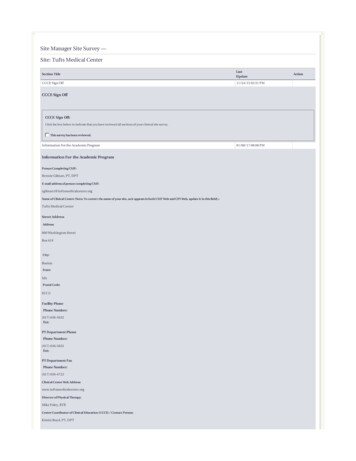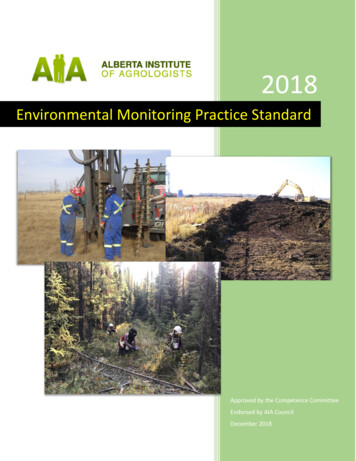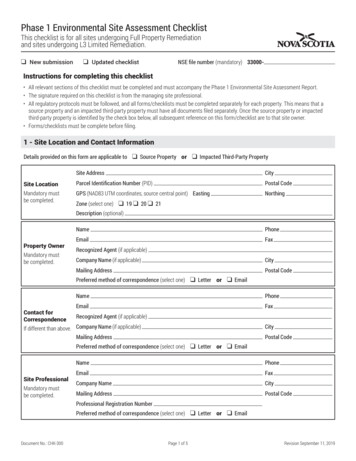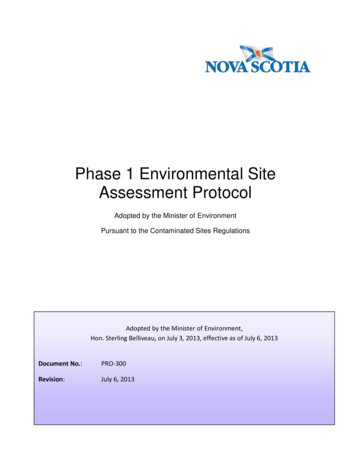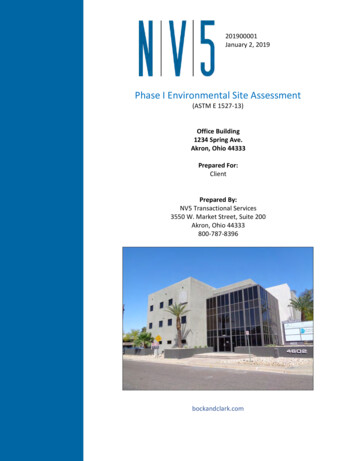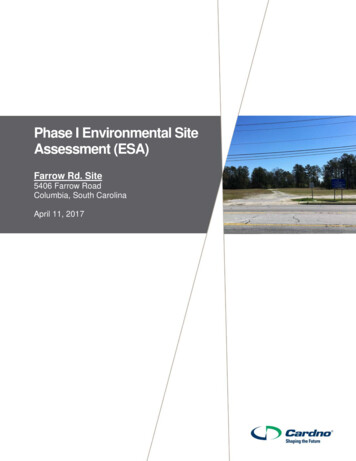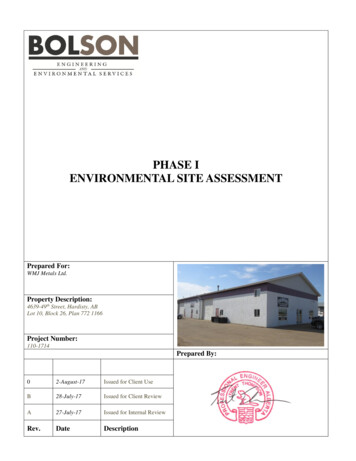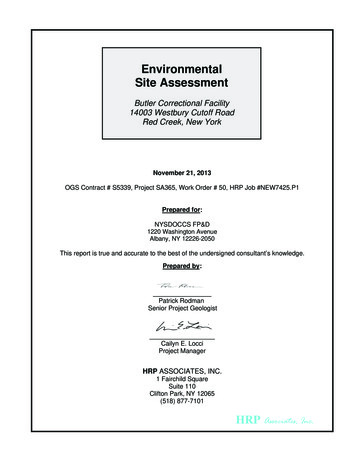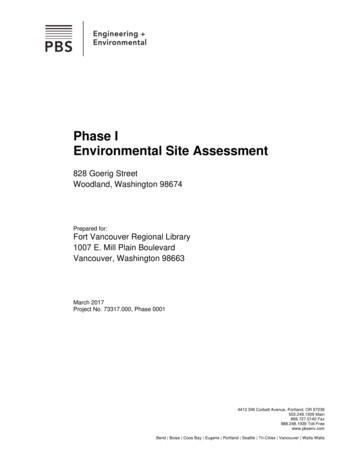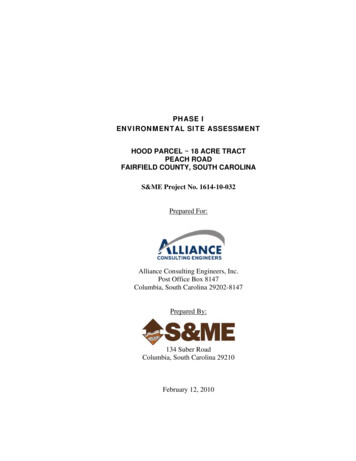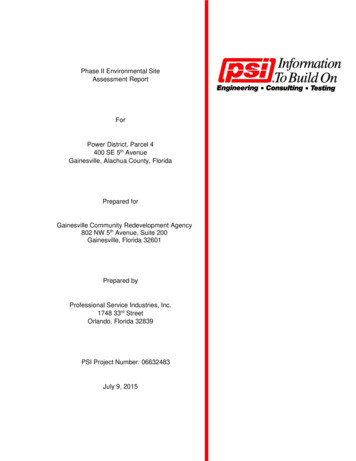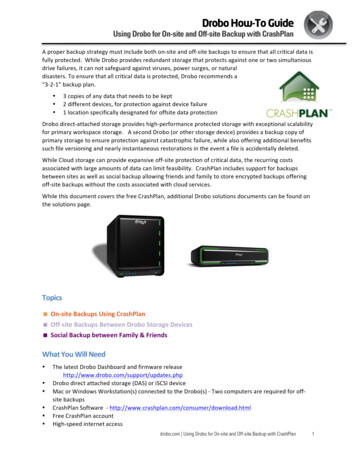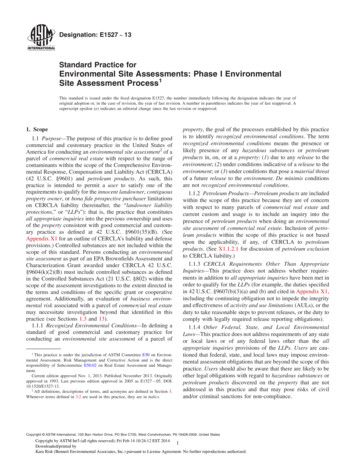
Transcription
Designation: E1527 13Standard Practice forEnvironmental Site Assessments: Phase I EnvironmentalSite Assessment Process1This standard is issued under the fixed designation E1527; the number immediately following the designation indicates the year oforiginal adoption or, in the case of revision, the year of last revision. A number in parentheses indicates the year of last reapproval. Asuperscript epsilon ( ) indicates an editorial change since the last revision or reapproval.1. Scope1.1 Purpose—The purpose of this practice is to define goodcommercial and customary practice in the United States ofAmerica for conducting an environmental site assessment2 of aparcel of commercial real estate with respect to the range ofcontaminants within the scope of the Comprehensive Environmental Response, Compensation and Liability Act (CERCLA)(42 U.S.C. §9601) and petroleum products. As such, thispractice is intended to permit a user to satisfy one of therequirements to qualify for the innocent landowner, contiguousproperty owner, or bona fide prospective purchaser limitationson CERCLA liability (hereinafter, the “landowner liabilityprotections,” or “LLPs”): that is, the practice that constitutesall appropriate inquiries into the previous ownership and usesof the property consistent with good commercial and customary practice as defined at 42 U.S.C. §9601(35)(B). (SeeAppendix X1 for an outline of CERCLA’s liability and defenseprovisions.) Controlled substances are not included within thescope of this standard. Persons conducting an environmentalsite assessment as part of an EPA Brownfields Assessment andCharacterization Grant awarded under CERCLA 42 U.S.C.§9604(k)(2)(B) must include controlled substances as definedin the Controlled Substances Act (21 U.S.C. §802) within thescope of the assessment investigations to the extent directed inthe terms and conditions of the specific grant or cooperativeagreement. Additionally, an evaluation of business environmental risk associated with a parcel of commercial real estatemay necessitate investigation beyond that identified in thispractice (see Sections 1.3 and 13).1.1.1 Recognized Environmental Conditions—In defining astandard of good commercial and customary practice forconducting an environmental site assessment of a parcel of1This practice is under the jurisdiction of ASTM Committee E50 on Environmental Assessment, Risk Management and Corrective Action and is the directresponsibility of Subcommittee E50.02 on Real Estate Assessment and Management.Current edition approved Nov. 1, 2013. Published November 2013. Originallyapproved in 1993. Last previous edition approved in 2005 as E1527 – 05. DOI:10.1520/E1527-13.2All definitions, descriptions of terms, and acronyms are defined in Section 3.Whenever terms defined in 3.2 are used in this practice, they are in italics.property, the goal of the processes established by this practiceis to identify recognized environmental conditions. The termrecognized environmental conditions means the presence orlikely presence of any hazardous substances or petroleumproducts in, on, or at a property: (1) due to any release to theenvironment; (2) under conditions indicative of a release to theenvironment; or (3) under conditions that pose a material threatof a future release to the environment. De minimis conditionsare not recognized environmental conditions.1.1.2 Petroleum Products—Petroleum products are includedwithin the scope of this practice because they are of concernwith respect to many parcels of commercial real estate andcurrent custom and usage is to include an inquiry into thepresence of petroleum products when doing an environmentalsite assessment of commercial real estate. Inclusion of petroleum products within the scope of this practice is not basedupon the applicability, if any, of CERCLA to petroleumproducts. (See X1.1.2.1 for discussion of petroleum exclusionto CERCLA liability.)1.1.3 CERCLA Requirements Other Than AppropriateInquiries—This practice does not address whether requirements in addition to all appropriate inquiries have been met inorder to qualify for the LLPs (for example, the duties specifiedin 42 U.S.C. §9607(b)(3)(a) and (b) and cited in Appendix X1,including the continuing obligation not to impede the integrityand effectiveness of activity and use limitations (AULs), or theduty to take reasonable steps to prevent releases, or the duty tocomply with legally required release reporting obligations).1.1.4 Other Federal, State, and Local EnvironmentalLaws—This practice does not address requirements of any stateor local laws or of any federal laws other than the allappropriate inquiries provisions of the LLPs. Users are cautioned that federal, state, and local laws may impose environmental assessment obligations that are beyond the scope of thispractice. Users should also be aware that there are likely to beother legal obligations with regard to hazardous substances orpetroleum products discovered on the property that are notaddressed in this practice and that may pose risks of civiland/or criminal sanctions for non-compliance.Copyright ASTM International, 100 Barr Harbor Drive, PO Box C700, West Conshohocken, PA 19428-2959. United StatesCopyright by ASTM Int'l (all rights reserved); Fri Feb 14 10:24:12 EST 20141Downloaded/printed byKara Risk (Bennett Environmental Associates, Inc.) pursuant to License Agreement. No further reproductions authorized.
E1527 131.1.5 Documentation—The scope of this practice includesresearch and reporting requirements that support the user’sability to qualify for the LLPs. As such, sufficient documentation of all sources, records, and resources utilized in conducting the inquiry required by this practice must be provided in thewritten report (refer to 8.1.9 and 12.2).1.2 Objectives—Objectives guiding the development of thispractice are (1) to synthesize and put in writing good commercial and customary practice for environmental site assessmentsfor commercial real estate, (2) to facilitate high quality,standardized environmental site assessments, (3) to provide apractical and reasonable standard practice for conducting allappropriate inquiries, and (4) to clarify an industry standardfor all appropriate inquiries in an effort to guide legalinterpretation of the LLPs.1.3 Considerations Beyond Scope—The use of this practiceis strictly limited to the scope set forth in this section. Section13 of this practice identifies, for informational purposes,certain environmental conditions (not an all-inclusive list) thatmay exist on a property that are beyond the scope of thispractice, but may warrant consideration by parties to a commercial real estate transaction. The need to include an investigation of any such conditions in the environmental professional’s scope of services should be evaluated based upon,among other factors, the nature of the property and the reasonsfor performing the assessment (for example, a more comprehensive evaluation of business environmental risk) and shouldbe agreed upon between the user and environmental professional as additional services beyond the scope of this practiceprior to initiation of the environmental site assessment process.1.4 Organization of This Practice—This practice has thirteen sections and five appendixes. Section 1 is the Scope.Section 2 is Referenced Documents. Section 3, Terminology,has definitions of terms not unique to this practice, descriptionsof terms unique to this practice, and acronyms. Section 4 isSignificance and Use of this practice. Section 5 providesdiscussion regarding activity and use limitations. Section 6describes User’s Responsibilities. Sections 7 – 12 are the mainbody of the Phase I Environmental Site Assessment, includingevaluation and report preparation. Section 13 provides additional information regarding non-scope considerations (see1.3). The appendixes are included for information and are notpart of the procedures prescribed in this practice. Appendix X1explains the liability and defense provisions of CERCLA thatwill assist the user in understanding the user’s responsibilitiesunder CERCLA; it also contains other important informationregarding CERCLA, the Brownfields Amendments, and thispractice. Appendix X2 provides the definition of the environmental professional responsible for the Phase I EnvironmentalSite Assessment, as required in the “All Appropriate Inquiries”Final Rule (40 C.F.R. Part 312). Appendix X3 provides anoptional User Questionnaire to assist the user and the environmental professional in gathering information from the user thatmay be material to identifying recognized environmental conditions. Appendix X4 provides a recommended table of contents and report format for a Phase I Environmental SiteAssessment. Appendix X5 summarizes non-scope considerations that persons may want to assess.1.5 This standard does not purport to address all of thesafety concerns, if any, associated with its use. It is theresponsibility of the user of this standard to establish appropriate safety and health practices and determine the applicability of regulatory limitations prior to use.1.6 This practice offers a set of instructions for performingone or more specific operations. This document cannot replaceeducation or experience and should be used in conjunctionwith professional judgment. Not all aspects of this practice maybe applicable in all circumstances. This ASTM standard is notintended to represent or replace the standard of care by whichthe adequacy of a given professional service must be judged,nor should this document be applied without consideration ofa project’s many unique aspects. The word “Standard” in thetitle means only that the document has been approved throughthe ASTM consensus process.2. Referenced Documents2.1 ASTM Standards:3E2091 Guide for Use of Activity and Use Limitations,Including Institutional and Engineering ControlsE2600 Guide for Vapor Encroachment Screening on Property Involved in Real Estate Transactions2.2 Federal Statutes:Comprehensive Environmental Response, Compensation,and Liability Act of 1980 (“CERCLA” or “Superfund”), as amended by Superfund Amendments and Reauthorization Act of 1986 (“SARA”) and Small BusinessLiability Relief and Brownfields Revitalization Act of2002 (“Brownfields Amendments”), 42 U.S.C. §§9601 etseq.Emergency Planning and Community Right-To-Know Act of1986 (“EPCRA”), 42 U.S.C. §§11001 et seq.Freedom of Information Act, 5 U.S.C. §552, as amended byPublic Law No. 104-231, 110 Stat. 3048Resource Conservation and Recovery Act (also referred to asthe Solid Waste Disposal Act), as amended (“RCRA”), 42U.S.C §6901 et seq.2.3 USEPA Documents:“All Appropriate Inquiries” Final Rule, 40 C.F.R. Part 312Chapter 1 EPA, Subchapter J-Superfund, EmergencyPlanning, and Community Right-To-Know Programs, 40C.F.R Parts 300-399National Oil and Hazardous Substances Pollution Contingency Plan, 40 C.F.R. Part 3002.4 Other Federal Agency Document:OSHA Hazard Communication Regulation, 29 C.F.R.§1910.12003. Terminology3.1 This section provides definitions, descriptions of terms,and a list of acronyms for many of the words used in thispractice. The terms are an integral part of this practice and arecritical to an understanding of the practice and its use.3For referenced ASTM standards, visit the ASTM website, www.astm.org, orcontact ASTM Customer Service at service@astm.org. For Annual Book of ASTMStandards volume information, refer to the standard’s Document Summary page onthe ASTM website.Copyright by ASTM Int'l (all rights reserved); Fri Feb 14 10:24:12 EST 20142Downloaded/printed byKara Risk (Bennett Environmental Associates, Inc.) pursuant to License Agreement. No further reproductions authorized.
E1527 133.2 Definitions:3.2.1 abandoned property—property that can be presumedto be deserted, or an intent to relinquish possession or controlcan be inferred from the general disrepair or lack of activitythereon such that a reasonable person could believe that therewas an intent on the part of the current owner to surrenderrights to the property.3.2.2 activity and use limitations—legal or physical restrictions or limitations on the use of, or access to, a site or facility:(1) to reduce or eliminate potential exposure to hazardoussubstances or petroleum products in the soil, soil vapor,groundwater, and/or surface water on the property, or (2) toprevent activities that could interfere with the effectiveness ofa response action, in order to ensure maintenance of acondition of no significant risk to public health or the environment. These legal or physical restrictions, which may includeinstitutional and/or engineering controls, are intended to prevent adverse impacts to individuals or populations that may beexposed to hazardous substances and petroleum products in thesoil, soil vapor, groundwater, and/or surface water on theproperty. See Note 1.NOTE 1—The term AUL is taken from Guide E2091 to include bothlegal (that is, institutional) and physical (that is, engineering) controlswithin its scope. Other agencies, organizations, and jurisdictions maydefine or utilize these terms differently (for example, EPA and Californiado not include physical controls within their definitions of “institutionalcontrols.” Department of Defense and International County/City Management Association use “Land Use Controls.” The term “land use restrictions” is used but not defined in the Brownfields Amendments).3.2.3 actual knowledge—the knowledge actually possessedby an individual who is a real person, rather than an entity.Actual knowledge is to be distinguished from constructiveknowledge that is knowledge imputed to an individual orentity.3.2.4 adjoining properties—any real property or propertiesthe border of which is contiguous or partially contiguous withthat of the property, or that would be contiguous or partiallycontiguous with that of the property but for a street, road, orother public thoroughfare separating them.3.2.5 aerial photogr
Environmental Site Assessments: Phase I Environmental Site Assessment Process1 This standard is issued under the fixed designation E1527; the number immediately following the designation indicates the year of original adoption or, in the case of revision, the year of last revision. A number in parentheses indicates the year of last reapproval. AFile Size: 444KBPage Count: 47
